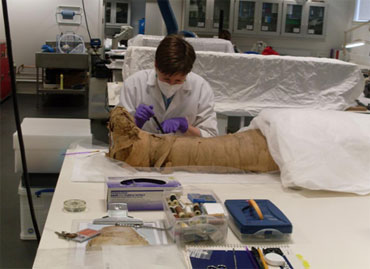CT scans of the mummy of Iufenamun show this is a well preserved adult male. There is a cut in the left side of the body where all the internal organs, except the heart, were removed. The heart was left in place because it was believed to be the centre of intelligence and feeling, and needed in the afterlife.

The removed organs were dehydrated in Natron, a natural salt, before being wrapped and returned to the body. The body was also dried in Natron, and stuffed with fabric to make it look life-like before being ceremonially wrapped.
Condition of the linen wrappings
Most of the wrapping fabrics are in strips, wound around the individual limbs first, and then the whole body. Folded shrouds are placed across the body at the chest. At the time of mummification the shrouds would have been wrapped around the body and held in place with linen ties. The ties no longer exist on this mummy, but there is a section of narrow twisted fabric at the foot that could be remnants of one. This wrapping method and mummification process helps to date this mummy to the 21st Dynasty (3rd Intermediate Period). The mummy was placed on a stitching table, so the wrappings can be conserved underneath.
The textile wrappings and shrouds are all made of linen. Most of the fabrics that can be seen are a plain weave. Some are rough and coarse, and traditionally these fabrics were used for wrapping the limbs and the padding. The shrouds at the chest area are a finer weave. There are blue coloured stripes on some of the shrouds, and these will be analysed in the future to see what type of dye was used to colour the linen.
An interesting discovery was made during examination and analysis of the wrappings. There is a fabric on the head of the mummy that is different to all the rest. Weave analysis and research has shown that it is an early form of mending used for weak spots in linen. This supports the theory that mummy wrappings were often made from used clothing or textiles.

Treatment of the textile wrappings
The linen wrappings are fragile and weak. The most fragile are at the sides of the chest, and at the head and feet. These were now quite loose, with areas of damage in the form of breakage and loss. This could be the result of damage in antiquity, when the wrappings would have been disturbed as people tried to see what was inside them. Many of the wrappings were creased and no longer in the correct alignment, and some fragments were no longer attached.
The wrappings were carefully surface cleaned using low powered vacuum suction to remove particulate dust. The creases in the fibres were eased out by relaxing them using the controlled introduction of moisture through a porous membrane called Gore-tex™. Care was taken by the use of barrier layers to ensure that only the individual wrapping being worked on was affected by the moisture.
The loose wrappings were then put back in the correct alignment. Those on the underside of the body were assessed and treated working on a stitching table, which enabled access to the underside of the mummy for the first time. The correct location for the loose pieces was determined by looking at the weave structure and lining up the edges.
The wrappings were then secured in place so that they would not suffer further damage in the future. The textiles were too fragile to stitch through, and it is one of the principles of modern conservation to stabilise the object with as little interference as possible, and to make it reversible wherever possible. For this reason the chosen treatment was to ‘wrap’ the mummy in nylon net, dyed to be virtually invisible. This held all the linen wrappings closely to the body, and stitching the net to itself avoided any working through the original fibres.
Once completed, the mummy was replaced in the conserved coffin of Iufenamun.

